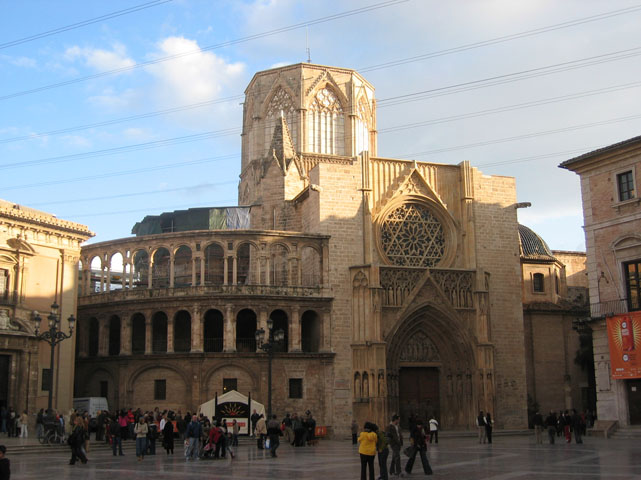Valencia Cathedral

Alfonso de Borja, Rodrigo de Borja and Cesare Borgia held their title.
During the fifteenth century the city experienced a period of great economic and cultural development under the auspices of King Alfonso V, the Magnanimous. In 1429, Alfonso de Borja receives the bishopric from him after his efforts to resolve the Western schism in the Catholic Church. He remains in the episcopal see until 1438, the year in which he sails for Italy, where he would become Pope Calixtus III.
His nephew, Rodrigo de Borja, succeeded him in 1458, maintaining his residence in Rome. He will step on the Valencian lands in 1472 as cardinal and legate of the Pope. The Borgia dynasty continues to maintain its influence in the diocese since, in 1482, when he was only six years old, Cesare, son of Rodrigo de Borja, became a canon of the cathedral.
In 1492, after the election of his father as Alexander VI, Cesare Borgia's ecclesiastical career was boosted with several appointments, among which the rich archbishopric of Valencia stands out, which he resigned after passing to the secular state, years later.
The cathedral will witness, already in 1571, the massive mass and preaching of Francisco de Borja, former Duke of Gandia and current general of the Jesuits.
The space occupied by the cathedral has housed different cults throughout its history. It was probably a temple dedicated to Diana in Roman times, the Goths dedicated it to the Savior, the Muslims built their mosque, the Cid gave it to Saint Peter the Apostle and finally, Jaume I placed it under the patronage of the Virgin Mary. Gregory IX, in 1239, recognized the conversion of the mosque into a cathedral.
The current temple was the pawn of the third bishop of the reconquered Valencia, Andreu de Albalat, who ordered its construction in 1262.
The church has three naves, with a transept covered with a dome, from the 15th century, and a polygonal apse. The set is an overlay of styles. The door of the Palau or the Almoina, in the Romanesque style, built between 1260 and 1270, was its first entrance door.
That of the Apostles, facing the Plaza de la Virgen, dates from the 14th century and is decorated with figures of the apostles that have lost their original polychromy.
In the middle of the 14th century, between 1356 and 1369, the chapel of the Holy Chalice was built, originally intended as the Theology Classroom and later as the Chapter House.
The Valencian cathedral, head of an archdiocese, unlike others, never had a cloister; It did not have a chapter house either, so the chapter was forced to use the old theology classroom, the current chapel of the Holy Chalice, for this purpose.
In 1381 the first stones of a free-standing tower called "Campanar Nou" or "Torre del Micalet" were laid, with an octagonal floor plan, which became, due to its height, an emblematic building in the city, being attached to the cathedral in the fifteenth century.
In 1566 the construction of the Balcones del Cabildo began, a gallery that externally surrounds the ambulatory and in 1703 the main façade, known as the Irons, was projected due to the fence that surrounds it.
The cathedral has a chapel dedicated to Saint Francisco de Borja, where three important canvases are exhibited: Saint Francisco de Borja
before the corpse of Empress Isabella, by Mariano Salvador Maella (1787), and two works on Saint Francisco de Borja, by Francisco de Goya (1788).
The temple underwent an attempt to unify styles at the end of the 18th century that affected constructive and ornamental elements.






